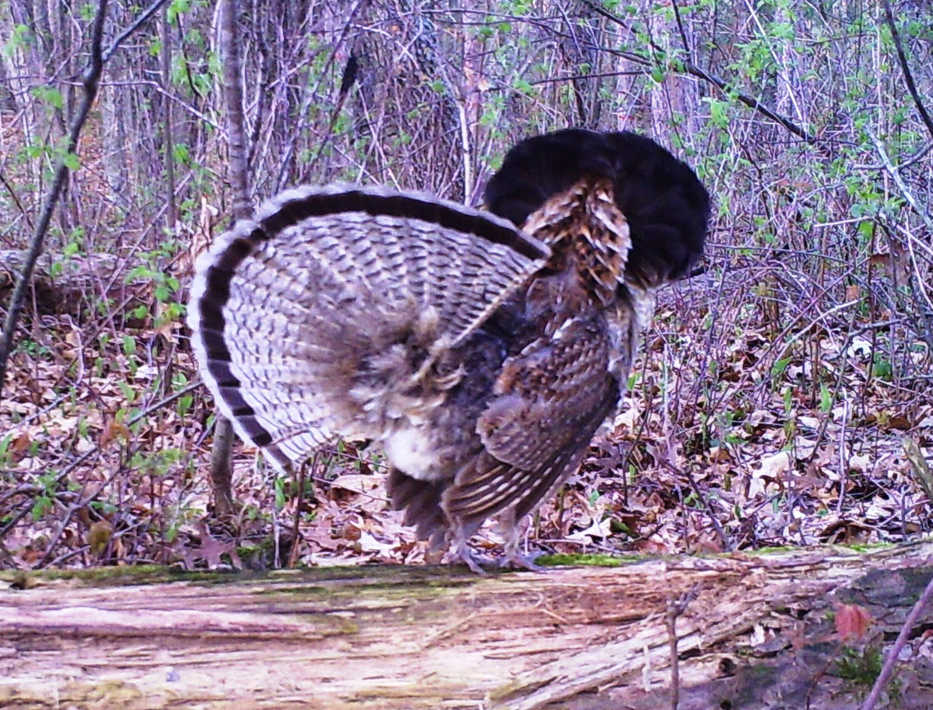I don’t hunt game birds much anymore, partly because I don’t have a decent bird dog and partly because ptarmigan and spruce grouse just don’t have that magical way of flushing when you least expect it. Somehow ruffed grouse choose to fly when you’re ducking under brambles or when a tree is between you and them. It’s not surprising that the 2003 Grouse Hunter’s Guide states the “ruffed grouse is the most difficult game bird to bag in North America.” I confess I started drinking coffee in high school not to study, but to prepare myself for the afternoon hunt.
That same book provides the hunting statistics for the 357 members of the Loyal Order of Dedicated Grouse Hunters in 2001-02. While some hunters shot more than 30 birds during that hunting season, the average take was 8 birds per hunter, representing 24 shots and 48 hours of hunting. Presumably the Loyal Order really is comprised of dedicated grouse hunters. When surveys include run-of-the-mill hunters, success rates drop to 1 bird killed per 6 or 7 shots.
I have (or had) bragging rights. In the early 1980s, I spent most of a year working in central Wisconsin at the Sandhill Wildlife Demonstration Area. Among other tasks, I was paid to chase down male grouse as they drummed on their logs in the spring. I thought I had died and gone to heaven. That fall, I hunted them and their broods, shooting almost 50 birds, making me the No. 1 grouse killer in Wood County that year based on hunter check station tallies.
So I’m a little disappointed that ruffed grouse aren’t native to the Kenai Peninsula. They exist throughout the boreal forest wherever hardwoods occur which means, in Alaska, they are found in the Yukon, Tanana and Kuskokwim river valleys. They also occur in Southeast Alaska along the lower Stikine and Taku rivers.
Why they don’t occur naturally south of the Alaska Range likely has to do with glaciation as their natural distribution in Alaska roughly coincides with those of tamarack (larch) and wood bison. Unlike spruce grouse that eat spruce needles and buds in winter, ruffed grouse prefer male flower buds of aspen in winter and they often roost under snow during extreme cold — so perhaps the distribution of aspen with adequate snow depth ultimately limits their distribution in the Far North.
Yet when 140 ruffed grouse were transplanted from south of Fairbanks to the Matanuska Valley during 1988-1990, they immediately began to populate the area, eventually dispersing 80 miles from their original release sites and are now spreading down the west side of the Cook Inlet.
But when 232 grouse were introduced to the Kenai Peninsula in 1995-97, the results weren’t so spectacular. They were released on sites at Atkins Road near Sterling, Quartz Creek north of Sunrise, and Captain Cook State Park. There was clearly some early breeding as 7 broods were sighted by the end of 1997 but drumming grouse surveys were discontinued after five years. Although hunting regulations still allow the harvest of 1 ruffed grouse per day in Game Management Units 7 and 15, you’ll be hard pressed to find any ruffed grouse.
I suspect the introduction didn’t take well because aspen tends to grow in burned areas on the Kenai Lowlands whereas deeper snow occurs in the mountains. Ruffed grouse in Alaska need both, not one or the other. To make matters worse, the release occurred almost 3 decades after the last big wildfire north of the Sterling Highway in 1969, past prime for ruffed grouse that prefer 15 to 20 year-old aspen stands. There have been a handful of recent sightings of ruffed grouse in the Skilak Wildlife Area on the Kenai National Wildlife Refuge in 2014 and near Tern Lake in 2011, but I personally haven’t heard a drumming grouse in my 15 years on the peninsula.
When ruffed grouse drum, they neither beat their wings on the log nor are they beat on each other. The low-frequency drumming noise is created by the vacuum formed from their cupped wings on the upstroke. Part of their nuptial noise-making behavior on the log (or sometimes a hummock) involves the male erecting its neck feathers (the “ruff”) while fanning out its tail feathers. Its scientific name, “Bonasa umbellus,” refers to the similarities between the drumming and the bellowing of bulls or bison (Bonasa), and its ruffed neck feathers and an umbrella (umbellus).
Unlike spruce grouse, ruffed grouse populations vary with the 10-year snowshoe hare-lynx cycle. However, their peaks and lows lag behind snowshoe hares, suggesting that lynx switch to grouse as their primary prey only after hare populations start to decline.
Ruffed grouse still range as far south as northern Georgia, following the Appalachian Mountains. Fossil evidence from 15,000 years ago indicates that ruffed grouse were common even further south in Louisiana, Florida and Alabama during the Wisconsin Ice Age. With the accelerated warming of our contemporary climate, ruffed grouse populations in their southern range are likely to wink out. But my guess is that they will do well in interior Alaska in response to more wildfire and the conversion of softwood to hardwood.
Dr. John Morton is the supervisory biologist at Kenai National Wildlife Refuge. You can find more information about the refuge at http://kenai.fws.gov or http://www.facebook.com/kenainationalwildliferefuge.

